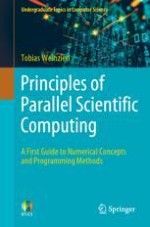2021 | OriginalPaper | Buchkapitel
3. Our Model Problem (Our First Encounter with the Explicit Euler)
verfasst von : Tobias Weinzierl
Erschienen in: Principles of Parallel Scientific Computing
Aktivieren Sie unsere intelligente Suche, um passende Fachinhalte oder Patente zu finden.
Wählen Sie Textabschnitte aus um mit Künstlicher Intelligenz passenden Patente zu finden. powered by
Markieren Sie Textabschnitte, um KI-gestützt weitere passende Inhalte zu finden. powered by
